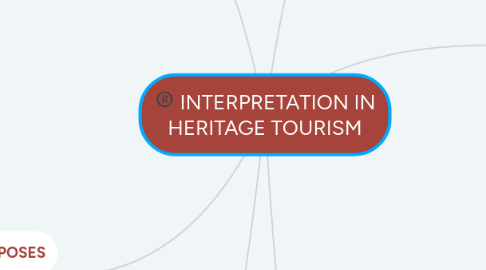
1. PRINCIPLES
1.1. Interpretation for the site must relate to visitor's personality&experiences
1.2. Interpretation is not all about information, but a qualified interpretation must be based on information
1.3. Interpretation is a combination of many arts: presentation and communication skills; person skills; imaginary; creative
1.4. Interpertation present the whole thing of the heritage but not a part of it
1.5. The aim of interpretation is not about instruction but is provocation
1.6. Interpretation must be flexible using different approaches for visitor's demand
2. BENEFITS AND PURPOSES
2.1. Education
2.1.1. educate and make visitors understand & appreciate the site
2.1.2. provide education for both formal and infornal learning
2.2. Entertainment
2.2.1. Effective medium for educating visitors with fun and enjoyment
2.2.2. Add public appeal and create CA + solve money issue
2.2.3. include humor; high- tech media ; re - enactments
2.3. Preservation & Conservation
2.3.1. raise awareness of protection and conservation
2.3.2. stimulate sense of ownership and care
2.4. Crowd management
2.4.1. good way to control the group, avoid sensitive areas
2.5. Income earners
2.5.1. bring positive income impacts for heritage community
3. INTERPRETATIVE TOOLS
3.1. Tour guide
3.2. Actors/ Role players
3.3. Attendants
3.4. Printed materials and signage
3.5. Hands_on displays
3.6. Individual audio tours
3.7. Modern tech - devices
4. DEFINITION
4.1. Freeman Tilden
4.2. not just about telling info but turning the dead info to be alive
4.3. make visitor understand the heritage's meaning and values
4.4. raise visitors' awareness of conservation; protection or at least do something for the heritage sites
5. TYPES
5.1. Historic site interpretation
5.2. Countryside interpertation
5.3. Park interpretation
5.4. Community interpretaion
5.5. Heritage interpertation
6. VISITOR DIVERSITY & INTERPRETIVE PROGRAMS
6.1. International visitors
6.1.1. multi- lingual methods
6.2. Disable and elder people
6.2.1. story telling and other media devices
6.2.2. Braille
6.2.3. equipments for disable people
6.3. Children
6.3.1. interesting media: buttons; music; lights
6.3.2. understandble
6.3.3. senses of emotions
6.4. Cultural sensitivity
6.4.1. recognize and except the right of visitors's different views rather than debasement
6.4.2. show empathy; respect towards visitors's background
6.5. Interpretive planning
6.5.1. Guiding principles: safety for visitors and employees;
6.5.2. Interpretaive approach and media must be realistic and friendly
6.5.3. Interpretation must have no negative impacts on cultural environment
6.5.4. Interpretation must be suitable for visitors to progress in their own pace

